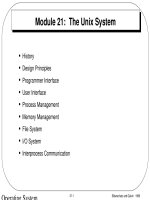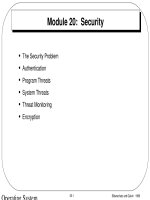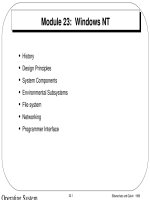Lecture Operating system concepts - Lecture 22
Bạn đang xem bản rút gọn của tài liệu. Xem và tải ngay bản đầy đủ của tài liệu tại đây (839.24 KB, 38 trang )
CSC 322 Operating Systems Concepts
Lecture - 22:
by
Ahmed Mumtaz Mustehsan
Special Thanks To:
Tanenbaum, Modern Operating Systems 3 e, (c) 2008 Prentice-Hall, Inc. (Chapter4) Silberschatz, Galvin and Gagne 2002, Operating System Concepts,
Ahmed Mumtaz Mustehsan, CIIT,
Chapter 4
File System
File System Management
Example File System
Lecture22
Ahmed Mumtaz
2
File System Management and Optimization
• Disk space management
• Manage Free Blocks (Discussed in the last
lecture)
• Manage Disk quota
• File System Backups
• File System Consistency
• File System Performance
Lecture-21
Ahmed Mumtaz
3
Disk Quotas (A fair distribution of disk space)
Multiuser OS enforce Disk Quota and ensure that the
users do not exceed their quota.
• Entry in open file table points to quota table
• One entry for each open file
• Places limits (soft, hard) on users disk quota
• System start warning the users exceeding soft limit
• User may ignore soft limit till number of warnings
left after that the user is not allowed to login. (hard
limit)
• Quota imposed on Blocks as well as on files.
• Illustration on next slide
Lecture22
Ahmed Mumtaz
4
Disk Quotas
Quotas are kept track of on a per-user basis in a quota table.
When user logins within soft limit a warning message to delete
files before logging out.
Lecture22
Ahmed Mumtaz
5
File System Backups
Take Disk Backup on Tape
Backups to tape are generally made to handle
any of two potential problems:
• Recover from disaster (e.g. disk crash,
nature)
• Recover from stupidity (e.g. Delete file by
mistake)
• Tapes hold hundreds of gigabytes and are very
cheap
Lecture22
Ahmed Mumtaz
6
File System Backups
What to Backup?
• Don’t want to back up whole file system
• Can get binaries from manufacturer’s CD’s
• Temporary files don’t need to be backed up
• Special files (I/O) don’t need it
Lecture22
Ahmed Mumtaz
7
Back up Incrementally
How to Backup?
• Complete dump weekly/monthly and daily
dump of modified files since big dump
• =>to restore FS need to start with full dump and
include modified files => need better algorithms
• Problem; If you want to compress data before
dumping it, it will optimize the space but if part
of the tape is bad…..( you will Loose
everything)
• Problem; It is hard to dump when system is
being used. Snapshot algorithms are available
to run backup
Lecture22
Ahmed Mumtaz
8
Dumping strategies
Physical-dump the whole thing.
• it is simple to implement
• Don’t want to dump
• Unused blocks => program needs access to the
unused block list and must write block number
for used blocks on tape
• Bad blocks; Handled by DC or Handled by OS
• If managed by Disk controller; it must detect
and replace them; user are not aware; no
backup, needed.
• If they are kept in a bad block area by the OS,
then Backup procedure must take care and
backup
Lecture22
Ahmed Mumtaz
9
Physical Dump; Good vs Bad
• The Good-easy to implement
• The bad
• Can’t skip a particular directory
• Can’t make incremental dumps
• Can’t restore individual files
• So physical dump Not used
• Use logical dumps
Lecture22
Ahmed Mumtaz
10
Logical Dumps
• Starts at directory and recursively dumps all
files/directories below it which have changed
since a given time
• Examine standard algorithm used by Unix. Dumps
all directories lie on the path to modified
file/directory because
• Can restore complete structure (paths) on
different computer
• Have the ability to restore a single file
Lecture22
Ahmed Mumtaz
11
File System Backups
A file system to be dumped. Squares are directories, circles
are files. Shaded items have been modified since last dump.
Each directory and file is labeled by its i-node number.
Lecture22
Ahmed Mumtaz
12
Logical Dump Algorithm
• Uses bitmap indexed by i-node
• 4 phases
• Phase 1-starts at root and marks bits for
modified files and all directories (a)
• Phase 2-walks the tree, unmarks directories
without modified files in/under them (b)
• Phase 3-go through i-nodes and dump
marked directories (c)
• Phase 4-dump files (d)
Lecture22
Ahmed Mumtaz
13
File System Backups
Bitmaps used by the logical dumping algorithm.
Lecture22
Ahmed Mumtaz
14
File
System
Backups
Algorithm
Lecture22
Ahmed Mumtaz
15
Restoring file on disk
• Start with empty FS on disk
• Restore most recent full dump. Directories first,
then files.
• Then do restore incremental dumps (they are in
order on the tape)
Lecture22
Ahmed Mumtaz
16
Restoring file on disk-issues
• Free block list must be reconstructed.
•
•
•
•
Easy to do? it is the complement of the used
blocks
Links to files have to be carefully restored
Files can have holes in them. Don’t want to
restore files with lots of zeroes in them (Hole
between data and stack segments)
Pipes can’t be dumped
Tape density is not increasing => need lots of
tapes and robots to get at them. Soon will need
disks to be the back-ups!!!
Lecture22
Ahmed Mumtaz
17
File System Consistency
• Crash before blocks written out results in an
inconsistent state=>
• Need utility program to check for consistency in
blocks and files
(fsck in Unix, scandisk in Windows)
• Uses two tables
• How many times is block present in a file
• How many times block is present in free list
Program then reads all the i-nodes of device,
(ignoring FS) and increments counters in their
respective tables. (Result next slide)
Lecture22
Ahmed Mumtaz
18
File System Consistency
(a)
(b)
(c)
(d)
File system states.
Consistent.
Missing block.
Duplicate block in free list.
Duplicate data block.
Lecture22
Ahmed Mumtaz
19
Solutions
a) If the file system is consistent, each block will
have a 1 either in the first table or in the second
table.
b) System crash result in missing block; No harm;
just missing; solution: put block on free list.
c) Block occurs twice on free list; may happen with
free list impossible with bitmap; solution: re-build
free list
d) Block occurs twice on blocks in use; Problem; If
either of files is removed, block will be put on free
list, now block is in use and free at the same time.
If both files are removed, the block will be twice
on the free list. solution: allocate a free block,
copy the contents
ofMumtaz
block into it, insert
Lecture22
Ahmed
20 the copy
File Consistency (consistency of directory
system)
It, too, uses a table of counters, but these are per
file, rather than per block.
• Look at files instead of blocks
• Use table of counters, one per file
• Start at root directory, descend, increment
counter each time file shows up in a directory
• Compares counts with link counts from the inodes. Have to be the same to be consistent
Problem: two kinds of errors can occur: the link
count in the i-node can be high or it can be low.
Solution: fixed by setting the link count in the inode to the correct value.
Lecture22
Ahmed Mumtaz
21
File System Performance (FSP)
• Read word from memory: 10 nsec
• Read word from Disk: 5-10 msec seek +
rotational delay 4- 6 msec + 100 MB/sec
transfer
• Cache blocks in memory
• Hash table (device and disk address) to locate
the desired address in the cache; for collisions
use linked chain solution.
• When a block is to be loaded in full cache;
some block needs to be replaced. Need
algorithm to replace cache blocks ; use paging
algorithms, e.g FIFO, 2nd Chance Clock, LRU
Lecture22
Ahmed Mumtaz
22
Caching (FSP)
The buffer cache data structures.
Lecture22
Ahmed Mumtaz
23
Replacement
• Problem with LRU-some blocks are infrequently
used, but have to be in memory
• i-node-needs to be re-written to disk if modified.
Crash could leave system in inconsistent state
• Modify LRU
• Is block likely to be used again?
• Is block essential to consistency of file
system?
Lecture22
Ahmed Mumtaz
24
Replacement
• Use categories-i-nodes, indirect blocks,
directory blocks, full data blocks, partial data
blocks
• Put ones that will be needed at the rear
• If block is needed and is modified, write it to
disk asap
Lecture22
Ahmed Mumtaz
25









